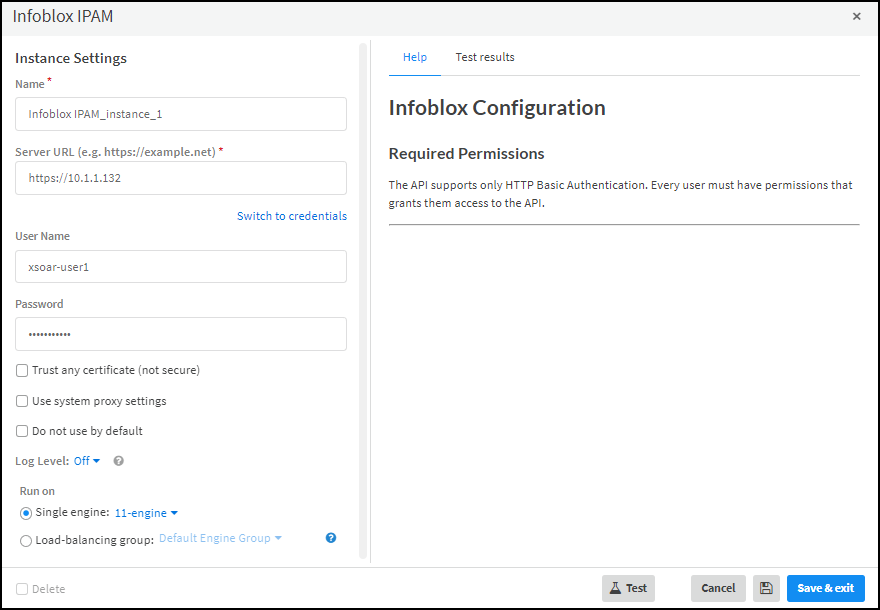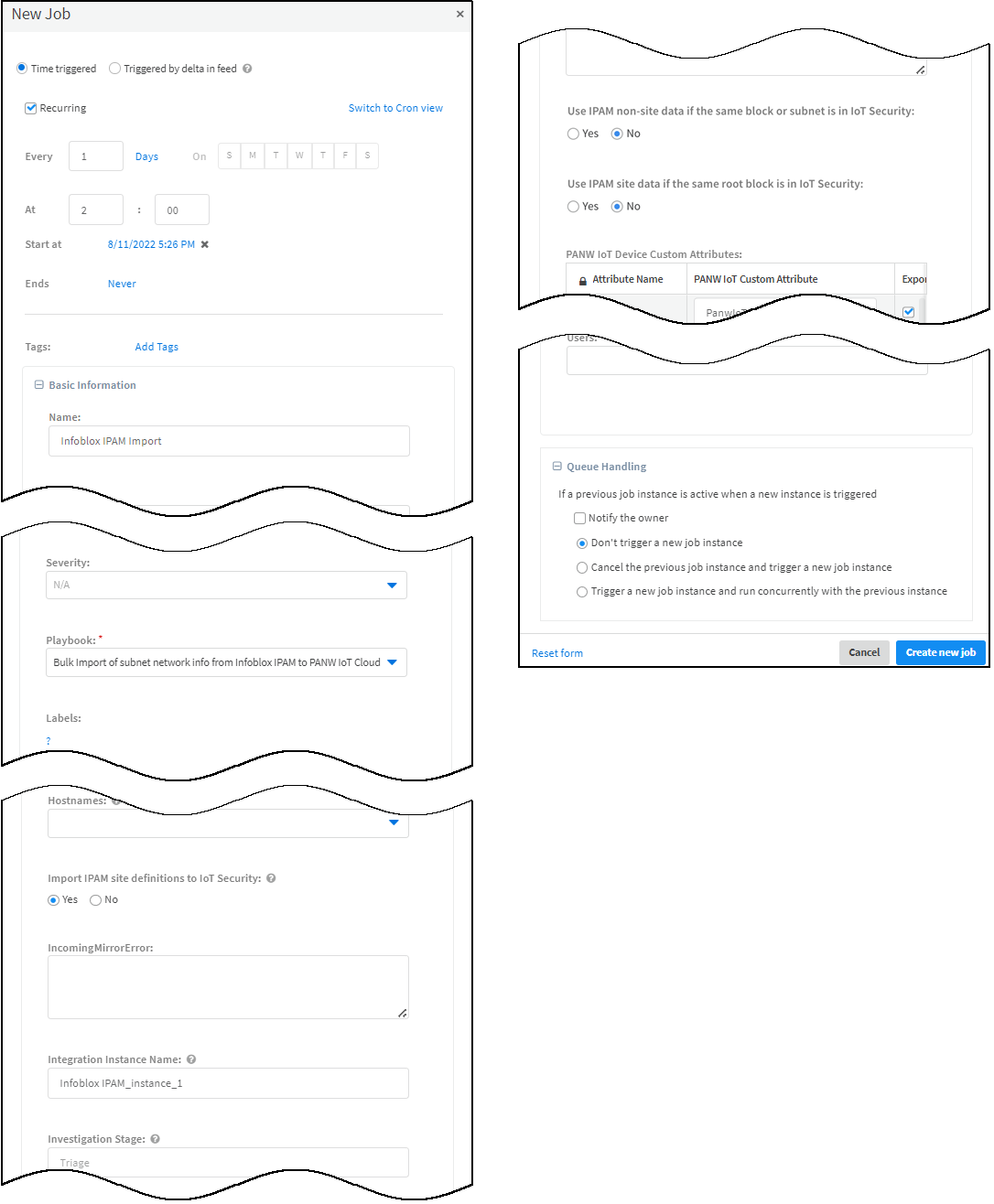Device Security
Set up Device Security and XSOAR for Infoblox Integration
Table of Contents
Expand All
|
Collapse All
Device Security Docs
Set up Device Security and XSOAR for Infoblox Integration
Set up Device Security and Cortex XSOAR to integrate with
Infoblox.
| Where Can I Use This? | What Do I Need? |
|---|---|
|
One of the following subscriptions:
One of the following Cortex XSOAR setups:
|
To set up Device Security to integrate through
Cortex XSOAR with an Infoblox Grid Master, you must add an XSOAR
engine to your network.
You must also configure Cortex XSOAR
with an Infoblox IPAM integration instance and a job to periodically
collect IPAM data from the Infoblox Grid Master. To do this, you
need the IP address or hostname of the Infoblox Grid Master API
and the username and password of the read/write user account that
the XSOAR engine will use when forming a secure connection with
it.
Cortex XSOAR Engine Installation
An on-premises XSOAR engine facilitates communications
between the Cortex XSOAR cloud and an Infoblox Grid Master. Although
it's possible to install an XSOAR engine on machines running Windows,
macOS, and Linux operating systems, only an engine on a Linux machine
supports Device Security integrations. For more information about operating
system and hardware requirements, see the Cortex Administrator’s Guide.
We recommend downloading the Cortex XSOAR engine using the shell
installer script and installing it on a Linux machine. This simplifies the
deployment by automatically installing all required dependencies and also
enables remote engine upgrades.
When placing
the XSOAR engine on your network, make sure it can form HTTPS connections
to the API of your Infoblox Grid Master. By default, XSOAR uses
TCP port 443.
The on-premises firewall must allow the Cortex XSOAR engine to form
HTTPS connections on TCP port 443 to the Cortex cloud at
https://<your-domain>.iot.demisto.live/. You can see the URL of your
Cortex XSOAR instance when you log in to Device Security
and click Integrations and then click Launch
Cortex XSOAR. It’s visible in the address bar
of the web page displaying the Cortex XSOAR interface.
To create an Cortex XSOAR engine, access the Cortex XSOAR
interface (from Device Security, click
Integrations and then click Launch
Cortex XSOAR). In the Cortex XSOAR UI,
click SettingsEngines+ Create New Engine. Choose
Shell as the type.
For Cortex XSOAR engine installation instructions, see Engine Installation.
For help troubleshooting Cortex XSOAR engines, including installations,
upgrades, connectivity, and permissions, see Troubleshoot Engines and Troubleshoot Integrations Running on
Engines.
Configure Device Security and Cortex XSOAR
- Log in to Device Security and from there access Infoblox IPAM settings in Cortex XSOAR.
- Log in to Device Security and then click Integrations.
- Device Security uses Cortex XSOAR to integrate with Infoblox Grid Masters, and the settings you must configure to integrate with it are in the XSOAR interface. To access these settings, click Launch Cortex XSOAR.The Cortex XSOAR interface opens in a new browser window.
- Click Settings in the left navigation menu, search for infoblox to locate it among other instances.
![]()
Configure the Infoblox IPAM integration instance.- Click Add instance to open the settings panel.
- Enter the following settings:Name: Use the default name of the instance or enter a new one.Server URL: Enter the IP address or hostname of the Infoblox Grid Master.Username: Type the name of the user account that you previously created in the Infoblox Grid Manager UI for the XSOAR engine to use when connecting to the Infoblox API.Password: Type the password associated with the user account.Run on Single engine: Choose the XSOAR engine that you want to communicate with this Infoblox Grid Master.
![]()
- When finished, click Run test or Test.If the test is successful, a Success message appears. If not, check that the settings were entered correctly and then test the configuration again.
![]()
- After the test succeeds, click Save & exit to save your changes and close the settings panel.
Create a job for XSOAR to query the Infoblox Grid Master for IPAM data about its subnets and IP CIDR blocks (referred to as networks and containers by Infoblox) and send them to Device Security.- Copy the name of the Infoblox IPAM integration instance you just created, click Jobs near the bottom of the left navigation menu and then click New Job at the top of the page.
- In the New Job panel that appears, enter the following and leave the other settings at their default values:Time triggered: (select)Recurring: Select this if you want to periodically import the Infoblox Grid Master for IPAM data. Leave it unselected to run the bulk data import job manually.Every: If you select Recurring, enter a number and set the interval value (Minutes, Hours, Days, or Weeks) and select the days or time of day to run the job. (If you don’t select specific days, then the job will run everyday by default.) This determines how often and when XSOAR queries the Infoblox Grid Master. For example: 1 day and 2:00Name: Enter a name for the job.Playbook: Choose Bulk Import of subnet network info from Infoblox IPAM to PANW IoT Cloud.Import IPAM site definitions to Device Security: Select Yes to import site definitions along with subnets from Infoblox IPAM into Device Security. Select No to import subnets without any site data.Integration Instance Name: Paste the instance name you copied a few moments ago.Use IPAM non-site data if the same block or subnet is in Device Security: Non-site data for an IP block or subnet consists of its VLAN and description. Select Yes if you want Infoblox non-site data to overwrite Device Security data when there are matching IP blocks and subnets. Select No if you don’t want Infoblox non-site data to overwrite Device Security data.Use IPAM site data if the same root block is in Device Security: Select Yes if you want the site data of a root IP block in Infoblox IPAM to overwrite site data for a matching root IP block in Device Security. Because child and grandchild IP blocks and subnets inherit their site from the root IP block that’s their parent or grandparent, the root block site is the one that decides the site for itself and all those below it. Select No if you don’t want Infoblox site data to overwrite Device Security site data for a matching root IP block.
![]()
- Click Create new job.
Enable the job and run it.- Check the Job Status for the job you created. If it’s Disabled, select its check box and then click Enable.
- After you enable it, keep the check box selected and click Run now. The Run Status changes from Idle to Running.If you configured the job to be run manually, it begins immediately. If you configured it to recur at a defined interval, it will start at the time you set. When it does start, XSOAR queries the Infoblox Grid Master for IPAM data, which it then forwards to the Device Security cloud.The first time you run a job, it triggers XSOAR to report the integration instance that the job references to Device Security, which then displays the instance on the Integrations page.
If you created more integration instances for multiple Infoblox Grid Masters, add more jobs as necessary. Be sure to run each job you create at least once to populate the Integrations page in Device Security with all the integration instances you’re using.Each Infoblox IPAM instance requires a separate job.When done, return to Device Security and check the status of the Infoblox IPAM integration instances.An integration instance can be in one of the following four states, which Device Security displays in the Status column on the Integrations page:- Active — the integration was configured and enabled and is functioning properly.Disabled — either the integration was configured but intentionally disabled or it was never configured and a job that references it is enabled and running.
- Error — the integration was configured and enabled but is not functioning properly, possibly due to a configuration error or network condition.
- Inactive — the integration was configured and enabled but no job has run for at least the past 60 minutes.
When you see that the status of an integration instance is Active, its setup is complete.




